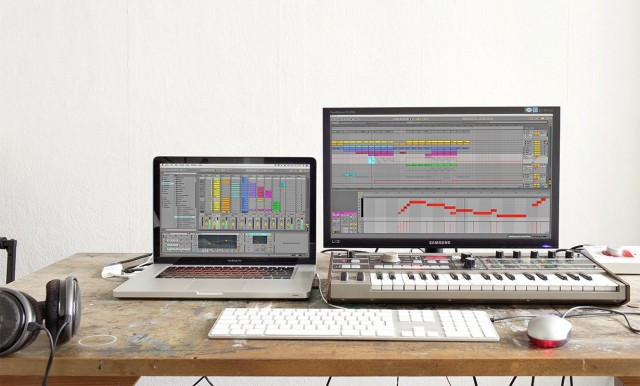
Live 9.1, in beta for some weeks, is now available to everyone. We’ve covered in some detail what 9.1 includes. But if you’re a Live 9 user, you shouldn’t hesitate to grab this. I’ve been splitting time between 9 stable and 9.1 beta, and the beta has been operating perfectly for me. If you have two monitors, of course, you get dual monitor support – or dual window support on bigger displays. (Sadly, I don’t have either at the moment, so haven’t been able to test that). But everyone will benefit from enhanced audio rendering and stability improvements – the latter essential if you’re upgrading to OS X Mavericks.
Now, that said, none of this would be terribly newsworthy. But the feature I’ve found made me want to use 9.1 is its new step sequencing features in Push.
Sounds like something basic, but I would go further. Before melodic step sequencing, I messed around with Push, but it wasn’t essential. With melodic step sequencing and automation sequencing, I’ve become a Push addict. Now, that doesn’t mean I step sequence everything – far from it; I’m a keyboardist. But the addition of these two features makes Push really feel like a complete vision, like a fully-fleshed-out musical tool. It’s not that I couldn’t live without those features. It’s that they really make it clear what Push is as a hardware extension of Ableton Live.
And, interestingly, user extensions and documentation are already going further than the product alone: with the help of fellow users, you can make this your own.
So, if you’re interested in diving in, here are some resources to get you going. And if you don’t have Push, we’ve also got some useful tools that can inspire anyone with the Live software, whether or not you have Push. Because, really, all of this is useless unless you’re making the original music that no one else can.
First, the official videos are a good place to start, and very nicely done and clear. Get started with step sequencing melodies and chords:
And get on to step automation, remembering Peter’s Golden Rule of Acid Techno: if you’re thinking about maybe you want to make some acid techno, the answer is yes. Yes, you should. (No, this feature isn’t for that. But… again, see the previous rule.)
For a different take on walking you through the same functionality, Manchester MIDI school also has a strong video on working with melodic step sequencing features:
But who says you have to use melodic step sequencing for notes? Josh Spoon uses the note modulation to create patterns of modulation, combining Push with the Max for Live device Momentary 8 Pro.
That same technique works with any MIDI hardware, obviously, not just Push, so to understand the excellence of this device – and the ways you might use it with other gear you already own – see the overview video:
Josh has a great article with his favorite Max for Live devices for Dubspot. With so many M4L creations out there, this gets you into some of the most powerful:
5 Max for Live Devices for Performance w/ Ableton Live! MOMENTARY_8 Pro, Isotonik 9, TEMPO, Already Played, PitchDrop
Ableton talked about Push as hardware for starting new musical ideas. It does so much, in fact, that it isn’t always clear how to use it in live performance. Berklee School of Music’s Loudon Stearns has done the most extensive look at how you might approach this, with a rich, half-hour tutorial on working with Push for performance. It’s I think a must-watch even if you’re a curious user of other hardware, interested in other ideas.
The solution for Loudon: focus on instruments. (Yes, yes, there was the whole controversy over whether Push can be called an instrument. Here, that gets laid to rest, by using it as a window into lots of instrumental and effect tools you can use in addition to the obvious clip-launching business.)
Covered in the video:
– building sampled instruments in Ableton’s Sampler
– building instrument racks and mapping macro controls
– using Live’s arpeggiator and Push’s repeat mode
– advanced modulation in Ableton’s Sampler
– clip editing and launch modes within Ableton Live
– advanced note modes in Push
– rhythmic performance techniques with Push
– using the touch strip on Push
For more of the basics of Push (not necessarily specific to 9.1), MusicTech had a nice text tutorial.
And to close out, whether you have Push or not, here are some resources to help you generate ideas and get moving around faster in Live.
First, you’ll want to know the shortcuts. Scott Gilmore at Pyramind Training reviews some favorite time savers, in case you haven’t yet learned them:
7 Useful Shortcuts / Key Commands in Ableton Live
If your loops’ repetitiveness is driving you loopy, MusicRadar reminds you that you can use the Random function already built into the free Impulse instrument in Live to vary them automatically:
Randomising trap hi-hats with Ableton Live’s Impulse
And to thaw you out of creative freezes this winter, the folks at EraserMice are giving away some free Max for Live devices that generate materials algorithmically.
The inspiration for these especially warms my heart: it harkens back to the algorithmic composition software M, once marketed by now-defunct Dr. T’s, now available from Cycling ’74. (Personal note: M was the first generative software I ever used, way back in the early 90s.) It’s about time to see M for M4L.
And there you have it. Here’s hoping the upgrade for you is a musical one.